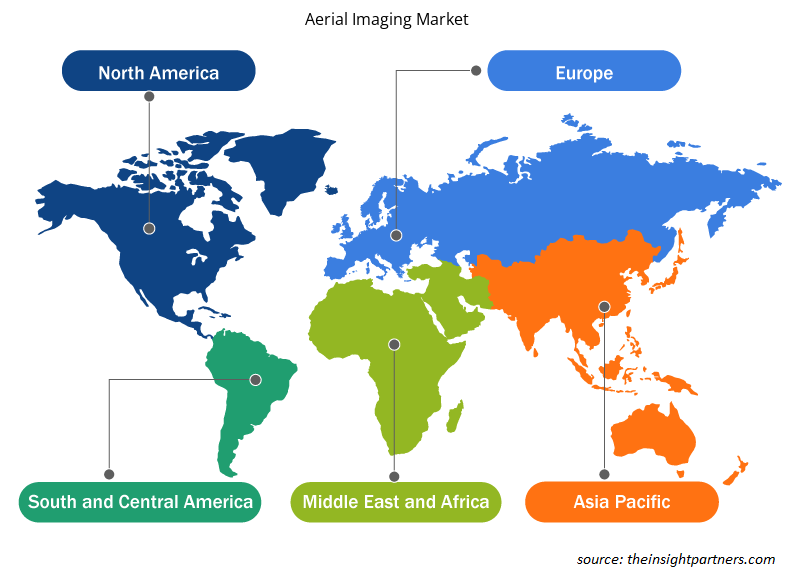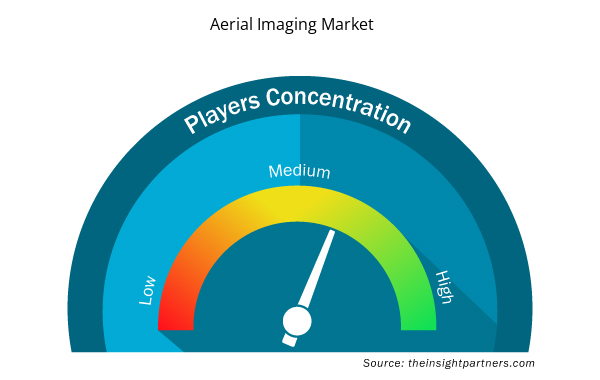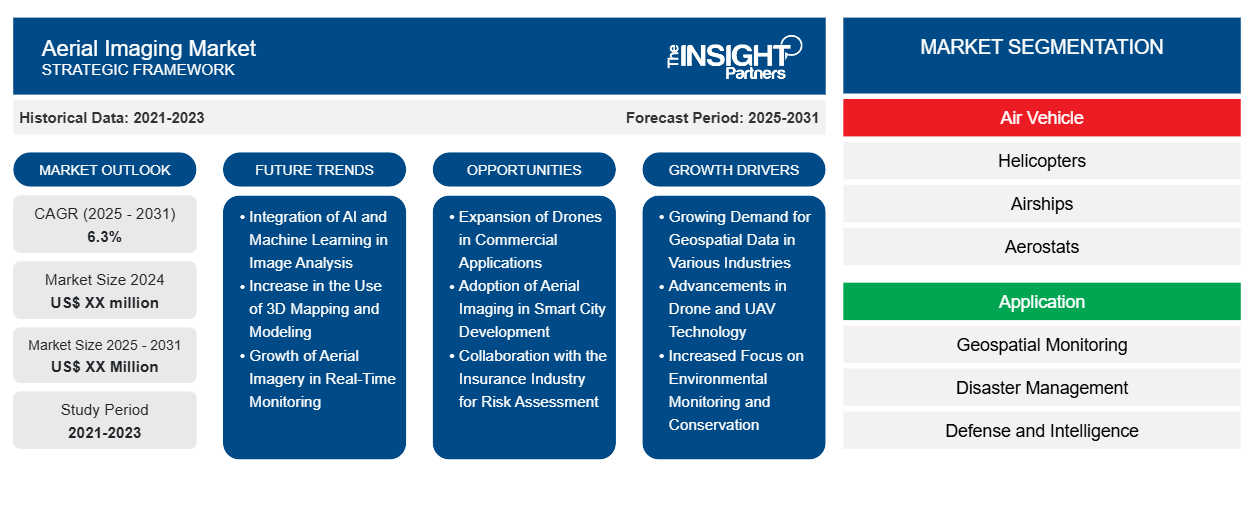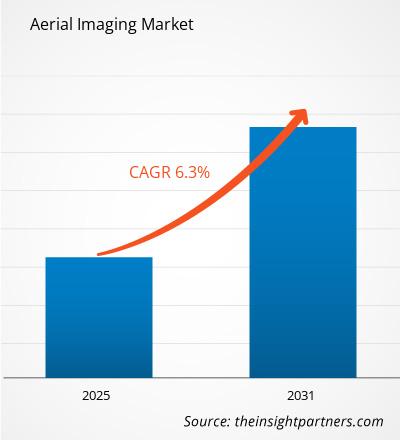Se espera que el mercado de imágenes aéreas registre una CAGR del 6,3 % entre 2023 y 2031, con un tamaño de mercado que se expandirá de US$ XX millones en 2023 a US$ XX millones en 2031.
El informe está segmentado por vehículo aéreo (helicópteros, dirigibles, aerostatos, vehículos aéreos no tripulados, otros); aplicación (monitoreo geoespacial, gestión de desastres, defensa e inteligencia, energía, gestión de recursos naturales, otros); usuario final (gobierno y ejército, empresas comerciales, silvicultura y agricultura, otros). El análisis global se desglosa aún más a nivel regional y por países principales. El informe ofrece el valor en USD para el análisis y los segmentos anteriores.
Propósito del Informe
El informe Aerial Imaging Market de The Insight Partners tiene como objetivo describir el panorama actual y el crecimiento futuro, los principales factores impulsores, los desafíos y las oportunidades. Esto proporcionará información a diversas partes interesadas del negocio, como:
- Proveedores/fabricantes de tecnología: Para comprender la dinámica cambiante del mercado y conocer las oportunidades potenciales de crecimiento, lo que les permitirá tomar decisiones estratégicas informadas.
- Inversionistas: Realizar un análisis exhaustivo de tendencias sobre la tasa de crecimiento del mercado, las proyecciones financieras del mercado y las oportunidades que existen en toda la cadena de valor.
- Órganos reguladores: Regular las políticas y vigilar las actividades del mercado con el objetivo de minimizar los abusos, preservar la confianza de los inversores y defender la integridad y la estabilidad del mercado.
Segmentación del mercado de imágenes aéreas
Vehículo aéreo
- Helicópteros
- Dirigibles
- Aerostatos
- Vehículos aéreos no tripulados (UAV)
- Otros
Solicitud
- Monitoreo geoespacial
- Gestión de desastres
- Defensa e Inteligencia
- Energía
- Gestión de recursos naturales
- Otros
Usuario final
- Gobierno y ejército
- Empresas comerciales
- Silvicultura y agricultura
- Otros
Geografía
- América del norte
- Europa
- Asia-Pacífico
- América del Sur y Central
- Oriente Medio y África
Geografía
- América del norte
- Europa
- Asia-Pacífico
- América del Sur y Central
- Oriente Medio y África
Personalice este informe según sus necesidades
Obtendrá personalización en cualquier informe, sin cargo, incluidas partes de este informe o análisis a nivel de país, paquete de datos de Excel, así como también grandes ofertas y descuentos para empresas emergentes y universidades.
- Obtenga las principales tendencias clave del mercado de este informe.Esta muestra GRATUITA incluirá análisis de datos, desde tendencias del mercado hasta estimaciones y pronósticos.
Factores impulsores del crecimiento del mercado de imágenes aéreas
- Demanda creciente de datos geoespaciales en diversas industrias: la creciente demanda de datos geoespaciales precisos en industrias como la agricultura, la construcción, el sector inmobiliario, la minería y la infraestructura es un factor clave para el mercado de imágenes aéreas. Las imágenes aéreas proporcionan datos sumamente precisos y actualizados que son fundamentales para los procesos de toma de decisiones en la gestión de tierras, el monitoreo de cultivos, la planificación urbana y la gestión de activos. Esta creciente dependencia de las imágenes aéreas para una mejor planificación y eficiencia operativa impulsa el crecimiento del mercado.
- Avances en la tecnología de drones y UAV: los rápidos avances en la tecnología de drones y UAV (vehículos aéreos no tripulados) han impulsado significativamente el mercado de imágenes aéreas. Los drones modernos están equipados con cámaras de alta resolución, sensores LiDAR y sistemas GPS que permiten obtener imágenes aéreas detalladas y precisas. Estas mejoras tecnológicas han hecho que las imágenes aéreas sean más accesibles, rentables y eficientes, impulsando su adopción generalizada en las industrias que requieren imágenes de alta calidad y en tiempo real para aplicaciones como cartografía, vigilancia y monitoreo ambiental.
- Mayor atención a la vigilancia y conservación del medio ambiente: a medida que aumentan las preocupaciones ambientales y se hace más urgente la necesidad de un desarrollo sostenible, las imágenes aéreas desempeñan un papel cada vez más importante en el seguimiento de los recursos naturales, la vida silvestre y los ecosistemas. Las imágenes aéreas se utilizan para rastrear la deforestación, monitorear los cuerpos de agua, analizar la salud del suelo y evaluar el impacto del cambio climático. Con el mayor enfoque en la conservación del medio ambiente y la aplicación de políticas, la demanda de soluciones de imágenes aéreas está aumentando, en particular para aplicaciones en investigación ambiental, gestión de desastres y vigilancia del clima.
Tendencias futuras del mercado de imágenes aéreas
- Integración de IA y aprendizaje automático en el análisis de imágenes: una tendencia clave en el mercado de imágenes aéreas es la integración de tecnologías de inteligencia artificial (IA) y aprendizaje automático (ML) en el análisis de imágenes. Los algoritmos de IA y ML pueden procesar grandes volúmenes de imágenes aéreas para detectar automáticamente patrones, clasificar objetos e identificar cambios a lo largo del tiempo. Esto mejora la eficiencia y la precisión de las aplicaciones de imágenes aéreas, en particular en industrias como la agricultura (monitoreo de la salud de los cultivos), la planificación urbana (detección de edificios e infraestructura) y la defensa (vigilancia y reconocimiento). El uso creciente de IA y ML mejora el valor de los datos de imágenes aéreas y amplía su gama de aplicaciones.
- Aumento del uso de la cartografía y el modelado en 3D: el uso de la cartografía y el modelado en 3D es una tendencia de rápido crecimiento en el mercado de las imágenes aéreas. Los drones equipados con cámaras de alta precisión y sensores LiDAR ahora pueden capturar mapas tridimensionales detallados de paisajes, edificios e infraestructura. Estos datos son valiosos para industrias como la construcción, la planificación urbana y la minería, donde el modelado en 3D ayuda con el análisis del sitio, el diseño del proyecto y el seguimiento del progreso de la construcción. La tendencia hacia las imágenes en 3D permite una representación más precisa y visual del terreno y las estructuras, ampliando los límites de lo que se puede lograr con las imágenes aéreas.
- Crecimiento de las imágenes aéreas en el monitoreo en tiempo real: existe una tendencia creciente hacia el uso de imágenes aéreas en tiempo real para aplicaciones como vigilancia en vivo, respuesta a desastres y monitoreo de tráfico. Con la capacidad de transmitir imágenes o videos en vivo desde drones o vehículos aéreos no tripulados, las empresas y las agencias gubernamentales pueden responder más rápidamente a situaciones emergentes. Esto es particularmente relevante en sectores como búsqueda y rescate, seguridad pública y monitoreo de infraestructura, donde la toma de decisiones rápida es crucial. La capacidad de capturar y analizar datos aéreos en tiempo real es una ventaja significativa en el mundo moderno impulsado por los datos, lo que fomenta la expansión del mercado.
Oportunidades de mercado en imágenes aéreas
- Expansión de los drones en aplicaciones comerciales: existe una importante oportunidad de crecimiento en el mercado de drones comerciales, que es un importante impulsor del mercado de imágenes aéreas. A medida que la tecnología de los drones se vuelve más asequible y versátil, su uso en diversos sectores comerciales, como la agricultura, el sector inmobiliario, la minería y la inspección de infraestructuras, se está expandiendo rápidamente. Los drones equipados con cámaras y sensores de alta resolución brindan datos valiosos para aplicaciones como análisis de la salud de los cultivos, estudios de propiedades e inspecciones aéreas de sitios de construcción y turbinas eólicas. La expansión del uso de drones en diferentes sectores ofrece inmensas oportunidades para las empresas que brindan servicios y soluciones de imágenes aéreas.
- Adopción de imágenes aéreas en el desarrollo de ciudades inteligentes: el desarrollo de ciudades inteligentes es otra oportunidad emergente para el mercado de imágenes aéreas. A medida que las ciudades crecen y se vuelven más complejas, las imágenes aéreas ayudan a los planificadores urbanos y desarrolladores a monitorear la infraestructura, evaluar el uso del suelo y garantizar una gestión eficiente del mismo. Los drones y los vehículos aéreos no tripulados pueden capturar imágenes actualizadas para su uso en cartografía, gestión del tráfico y monitoreo ambiental. A medida que las iniciativas de ciudades inteligentes ganan impulso en todo el mundo, la demanda de imágenes aéreas de alta calidad para respaldar el desarrollo urbano sostenible y la gestión de la infraestructura en tiempo real brindará importantes oportunidades de crecimiento para el mercado.
- Colaboración con la industria de seguros para la evaluación de riesgos: la industria de seguros presenta una oportunidad prometedora para el mercado de imágenes aéreas, en particular en la evaluación de riesgos, el procesamiento de reclamaciones y la respuesta ante desastres. Las imágenes aéreas, especialmente las obtenidas con drones, se pueden utilizar para evaluar los daños después de desastres naturales, como inundaciones, incendios forestales o huracanes, lo que proporciona información precisa a las aseguradoras. Además, las imágenes aéreas se pueden utilizar para inspecciones de propiedades, lo que ayuda a las aseguradoras a evaluar los riesgos con mayor precisión. A medida que el sector de seguros continúa aprovechando la tecnología para lograr operaciones más eficientes y una mejor gestión de riesgos, existe un potencial significativo para que el mercado de imágenes aéreas amplíe su papel en esta industria.
Perspectivas regionales del mercado de imágenes aéreas
Los analistas de Insight Partners explicaron en detalle las tendencias y los factores regionales que influyen en el mercado de imágenes aéreas durante el período de pronóstico. Esta sección también analiza los segmentos y la geografía del mercado de imágenes aéreas en América del Norte, Europa, Asia Pacífico, Oriente Medio y África, y América del Sur y Central.

- Obtenga datos regionales específicos para el mercado de imágenes aéreas
Alcance del informe de mercado de imágenes aéreas
| Atributo del informe | Detalles |
|---|---|
| Tamaño del mercado en 2023 | XX millones de dólares estadounidenses |
| Tamaño del mercado en 2031 | US$ XX millones |
| Tasa de crecimiento anual compuesta (CAGR) global (2023-2031) | 6,3% |
| Datos históricos | 2021-2022 |
| Período de pronóstico | 2024-2031 |
| Segmentos cubiertos | En vehículo aéreo
|
| Regiones y países cubiertos | América del norte
|
| Líderes del mercado y perfiles de empresas clave |
|
Densidad de actores del mercado de imágenes aéreas: comprensión de su impacto en la dinámica empresarial
El mercado de imágenes aéreas está creciendo rápidamente, impulsado por la creciente demanda de los usuarios finales debido a factores como la evolución de las preferencias de los consumidores, los avances tecnológicos y una mayor conciencia de los beneficios del producto. A medida que aumenta la demanda, las empresas amplían sus ofertas, innovan para satisfacer las necesidades de los consumidores y aprovechan las tendencias emergentes, lo que impulsa aún más el crecimiento del mercado.
La densidad de actores del mercado se refiere a la distribución de las empresas o firmas que operan dentro de un mercado o industria en particular. Indica cuántos competidores (actores del mercado) están presentes en un espacio de mercado determinado en relación con su tamaño o valor total de mercado.
Las principales empresas que operan en el mercado de imágenes aéreas son:
- Aeroptic, LLC
- Flor ASA
- Compañía de estudios aéreos Cooper
- Soluciones aéreas digitales, LLC.
- Tecnologías Eagle View, Inc.
Descargo de responsabilidad : Las empresas enumeradas anteriormente no están clasificadas en ningún orden particular.

- Obtenga una descripción general de los principales actores clave del mercado de imágenes aéreas
Puntos de venta clave
- Cobertura integral: el informe cubre de manera integral el análisis de productos, servicios, tipos y usuarios finales del mercado de imágenes aéreas, proporcionando un panorama holístico.
- Análisis de expertos: el informe se compila sobre la base de un profundo conocimiento de expertos y analistas de la industria.
- Información actualizada: El informe asegura relevancia comercial debido a su cobertura de información reciente y tendencias de datos.
- Opciones de personalización: este informe se puede personalizar para satisfacer los requisitos específicos del cliente y adaptarse adecuadamente a las estrategias comerciales.
Por lo tanto, el informe de investigación sobre el mercado de imágenes aéreas puede ayudar a abrir camino para descifrar y comprender el escenario de la industria y las perspectivas de crecimiento. Si bien puede haber algunas preocupaciones válidas, los beneficios generales de este informe tienden a superar las desventajas.
- Análisis histórico (2 años), año base, pronóstico (7 años) con CAGR
- Análisis PEST y FODA
- Tamaño del mercado Valor/volumen: global, regional, nacional
- Industria y panorama competitivo
- Conjunto de datos de Excel



Report Coverage
Revenue forecast, Company Analysis, Industry landscape, Growth factors, and Trends

Segment Covered
This text is related
to segments covered.

Regional Scope
North America, Europe, Asia Pacific, Middle East & Africa, South & Central America

Country Scope
This text is related
to country scope.
Preguntas frecuentes
Some of the customization options available based on request are additional 3-5 company profiles and country-specific analysis of 3-5 countries of your choice. Customizations are to be requested/discussed before making final order confirmation, as our team would review the same and check the feasibility.
The report can be delivered in PDF/PPT format; we can also share excel dataset based on the request.
The Aerial Imaging Market is estimated to witness a CAGR of 6.3% from 2023 to 2031
Some of the major trends driving the aerial imaging market are:
1. Integration of Artificial Intelligence (AI) with Imaging Technologies
2. Integration of Aerial Imaging in Construction
The major factors driving the aerial imaging market are:
1. Increasing Demand Aerial Surveillance
2. Increase in Military Spending
Trends and growth analysis reports related to Aerospace and Defense : READ MORE..
The List of Companies
- Aeroptic, LLC
- Blom ASA
- Cooper Aerial Surveys Co.
- Digital Aerial Solutions, LLC.
- Eagle View Technologies, Inc
- Fugro N.V.
- Global UAV Technologies Ltd
- Kucera International Inc
- Landiscor Real Estate Mapping
- Nearmap Ltd.
The Insight Partners performs research in 4 major stages: Data Collection & Secondary Research, Primary Research, Data Analysis and Data Triangulation & Final Review.
- Data Collection and Secondary Research:
As a market research and consulting firm operating from a decade, we have published and advised several client across the globe. First step for any study will start with an assessment of currently available data and insights from existing reports. Further, historical and current market information is collected from Investor Presentations, Annual Reports, SEC Filings, etc., and other information related to company’s performance and market positioning are gathered from Paid Databases (Factiva, Hoovers, and Reuters) and various other publications available in public domain.
Several associations trade associates, technical forums, institutes, societies and organization are accessed to gain technical as well as market related insights through their publications such as research papers, blogs and press releases related to the studies are referred to get cues about the market. Further, white papers, journals, magazines, and other news articles published in last 3 years are scrutinized and analyzed to understand the current market trends.
- Primary Research:
The primarily interview analysis comprise of data obtained from industry participants interview and answers to survey questions gathered by in-house primary team.
For primary research, interviews are conducted with industry experts/CEOs/Marketing Managers/VPs/Subject Matter Experts from both demand and supply side to get a 360-degree view of the market. The primary team conducts several interviews based on the complexity of the markets to understand the various market trends and dynamics which makes research more credible and precise.
A typical research interview fulfils the following functions:
- Provides first-hand information on the market size, market trends, growth trends, competitive landscape, and outlook
- Validates and strengthens in-house secondary research findings
- Develops the analysis team’s expertise and market understanding
Primary research involves email interactions and telephone interviews for each market, category, segment, and sub-segment across geographies. The participants who typically take part in such a process include, but are not limited to:
- Industry participants: VPs, business development managers, market intelligence managers and national sales managers
- Outside experts: Valuation experts, research analysts and key opinion leaders specializing in the electronics and semiconductor industry.
Below is the breakup of our primary respondents by company, designation, and region:

Once we receive the confirmation from primary research sources or primary respondents, we finalize the base year market estimation and forecast the data as per the macroeconomic and microeconomic factors assessed during data collection.
- Data Analysis:
Once data is validated through both secondary as well as primary respondents, we finalize the market estimations by hypothesis formulation and factor analysis at regional and country level.
- Macro-Economic Factor Analysis:
We analyse macroeconomic indicators such the gross domestic product (GDP), increase in the demand for goods and services across industries, technological advancement, regional economic growth, governmental policies, the influence of COVID-19, PEST analysis, and other aspects. This analysis aids in setting benchmarks for various nations/regions and approximating market splits. Additionally, the general trend of the aforementioned components aid in determining the market's development possibilities.
- Country Level Data:
Various factors that are especially aligned to the country are taken into account to determine the market size for a certain area and country, including the presence of vendors, such as headquarters and offices, the country's GDP, demand patterns, and industry growth. To comprehend the market dynamics for the nation, a number of growth variables, inhibitors, application areas, and current market trends are researched. The aforementioned elements aid in determining the country's overall market's growth potential.
- Company Profile:
The “Table of Contents” is formulated by listing and analyzing more than 25 - 30 companies operating in the market ecosystem across geographies. However, we profile only 10 companies as a standard practice in our syndicate reports. These 10 companies comprise leading, emerging, and regional players. Nonetheless, our analysis is not restricted to the 10 listed companies, we also analyze other companies present in the market to develop a holistic view and understand the prevailing trends. The “Company Profiles” section in the report covers key facts, business description, products & services, financial information, SWOT analysis, and key developments. The financial information presented is extracted from the annual reports and official documents of the publicly listed companies. Upon collecting the information for the sections of respective companies, we verify them via various primary sources and then compile the data in respective company profiles. The company level information helps us in deriving the base number as well as in forecasting the market size.
- Developing Base Number:
Aggregation of sales statistics (2020-2022) and macro-economic factor, and other secondary and primary research insights are utilized to arrive at base number and related market shares for 2022. The data gaps are identified in this step and relevant market data is analyzed, collected from paid primary interviews or databases. On finalizing the base year market size, forecasts are developed on the basis of macro-economic, industry and market growth factors and company level analysis.
- Data Triangulation and Final Review:
The market findings and base year market size calculations are validated from supply as well as demand side. Demand side validations are based on macro-economic factor analysis and benchmarks for respective regions and countries. In case of supply side validations, revenues of major companies are estimated (in case not available) based on industry benchmark, approximate number of employees, product portfolio, and primary interviews revenues are gathered. Further revenue from target product/service segment is assessed to avoid overshooting of market statistics. In case of heavy deviations between supply and demand side values, all thes steps are repeated to achieve synchronization.
We follow an iterative model, wherein we share our research findings with Subject Matter Experts (SME’s) and Key Opinion Leaders (KOLs) until consensus view of the market is not formulated – this model negates any drastic deviation in the opinions of experts. Only validated and universally acceptable research findings are quoted in our reports.
We have important check points that we use to validate our research findings – which we call – data triangulation, where we validate the information, we generate from secondary sources with primary interviews and then we re-validate with our internal data bases and Subject matter experts. This comprehensive model enables us to deliver high quality, reliable data in shortest possible time.


 Obtenga una muestra gratuita de este informe
Obtenga una muestra gratuita de este informe